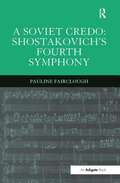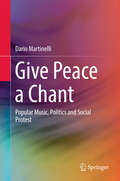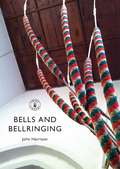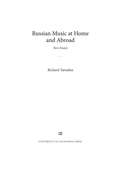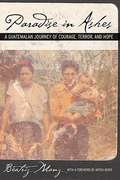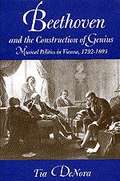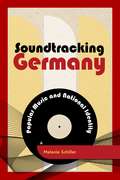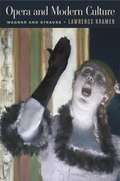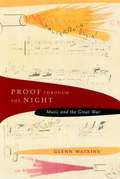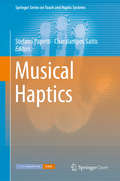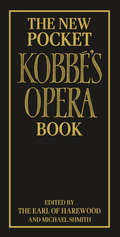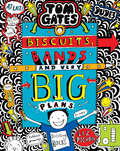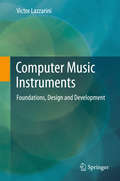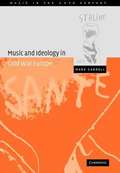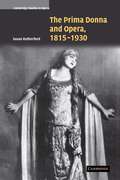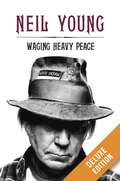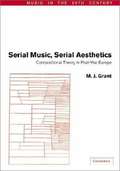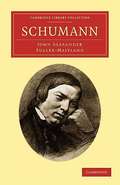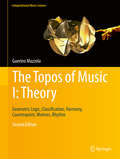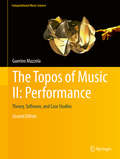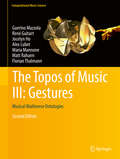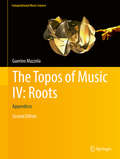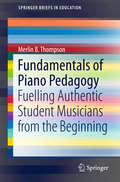- Table View
- List View
A Soviet Credo: Shostakovich's Fourth Symphony
by Pauline FaircloughComposed in 1935-36 and intended to be his artistic 'credo', Shostakovich's Fourth Symphony was not performed publicly until 1961. Here, Dr Pauline Fairclough tackles head-on one of the most significant and least understood of Shostakovich's major works. She argues that the Fourth Symphony was radically different from its Soviet contemporaries in terms of its structure, dramaturgy, tone and even language, and therefore challenged the norms of Soviet symphonism at a crucial stage of its development. With the backing of prominent musicologists such as Ivan Sollertinsky, the composer could realistically have expected the premiere to have taken place, and may even have intended the symphony to be a model for a new kind of 'democratic' Soviet symphonism. Fairclough meticulously examines the score to inform a discussion of tonal and thematic processes, allusion, paraphrase and reference to musical types, or intonations. Such analysis is set deeply in the context of Soviet musical culture during the period 1932-36, involving Shostakovich's contemporaries Shebalin, Myaskovsky, Kabalevsky and Popov. A new method of analysis is also advanced here, where a range of Soviet and Western analytical methods are informed by the theoretical work of Shostakovich's contemporaries Viktor Shklovsky, Boris Tomashevsky, Mikhail Bakhtin and Ivan Sollertinsky, together with Theodor Adorno's late study of Mahler. In this way, the book will significantly increase an understanding of the symphony and its context.
Give Peace a Chant: Popular Music, Politics and Social Protest
by Dario MartinelliThis monograph offers a unique analysis of social protest in popular music. It presents theoretical descriptions, methodological tools, and an approach that encompasses various fields of musicology, cultural studies, semiotics, discourse analysis, media studies, and political and social sciences. The author argues that protest songs should be taken as a musical genre on their own. He points out that the general approach, when discussing these songs, has been so far that of either analyzing the lyrics or the social context. For some reason, the music itself has been often overlooked. This book attempts to fill this gap. Its central thesis is that a complete overview of these repertoires demands a thorough interaction among contextual, lyrical, and musical elements together. To accomplish this, the author develops a novel model that systemizes and investigates musical repertoires. The model is then applied to four case studies, those, too, chosen among topics that are little (or not at all) frequented by scholars.
Bells and Bellringing (Shire Library #802)
by John HarrisonHandel called Britain 'The Ringing Isle' because he heard bells ringing everywhere he went. Behind the quintessentially English sound of bells ringing lies a unique way of hanging bells and a special way of ringing them that evolved in the late sixteenth century. Ringing has since developed and spread, with some 6,000 towers worldwide with bells hung in the English style, and most of them in England. Over 40,000 active ringers keep alive the traditions and skills of change ringing that have been handed down over many generations.The book is an introduction to the world of bells and bell-ringing. It explains how bells are made and how a ringing installation works. It explains the nature of change ringing, which has mathematical as well as musical aspects. It provides insights into the ringing community its origins and culture as well as its relationships with the Church and the community.
Russian Music At Home And Abroad: New Essays (PDF)
by Richard TaruskinThis new collection views Russian music through the Greek triad of “the Good, the True, and the Beautiful” to investigate how the idea of "nation" embeds itself in the public discourse about music and other arts with results at times invigorating, at times corrupting. In our divided, post–Cold War, and now post–9/11 world, Russian music, formerly a quiet corner on the margins of musicology, has become a site of noisy contention. Richard Taruskin assesses the political and cultural stakes that attach to it in the era of Pussy Riot and renewed international tensions, before turning to individual cases from the nineteenth century to the present. Much of the volume is devoted to the resolutely cosmopolitan but inveterately Russian Igor Stravinsky, one of the major forces in the music of the twentieth century and subject of particular interest to composers and music theorists all over the world. Taruskin here revisits him for the first time since the 1990s, when everything changed for Russia and its cultural products. Other essays are devoted to the cultural and social policies of the Soviet Union and their effect on the music produced there as those policies swung away from Communist internationalism to traditional Russian nationalism; to the musicians of the Russian postrevolutionary diaspora; and to the tension between the compelling artistic quality of works such as Stravinsky’s Sacre du Printemps or Prokofieff’s Zdravitsa and the antihumanistic or totalitarian messages they convey. Russian Music at Home and Abroad addresses these concerns in a personal and critical way, characteristically demonstrating Taruskin’s authority and ability to bring living history out of the shadows.
Opera And Modern Culture: Wagner And Strauss (PDF)
by Lawrence KramerMusicologist Lawrence Kramer argues that for the past two centuries the preoccupation of a group of famous operas with the limits of supremacy & debasement has come to define a normality that is the very opposite of the operatic.
Beethoven And The Construction Of Genius: Musical Politics In Vienna, 1792-1803 (PDF)
by Tia DeNoraIn this provocative account Tia DeNora reconceptualizes the notion of genius by placing the life and career of Ludwig van Beethoven in its social context. She explores the changing musical world of late eighteenth-century Vienna and follows the activities of the small circle of aristocratic patrons who paved the way for the composer's success. DeNora reconstructs the development of Beethoven's reputation as she recreates Vienna's robust musical scene through contemporary accounts, letters, magazines, and myths-a colorful picture of changing times. She explores the ways Beethoven was seen by his contemporaries and the image crafted by his supporters. Comparing Beethoven to contemporary rivals now largely forgotten, DeNora reveals a figure musically innovative and complex, as well as a keen self-promoter who adroitly managed his own celebrity. DeNora contends that the recognition Beethoven received was as much a social achievement as it was the result of his personal gifts. In contemplating the political and social implications of culture, DeNora casts many aspects of Beethoven's biography in a new and different light, enriching our understanding of his success as a performer and composer.
Our Journey
by Rak-SuRAK-WHAT? RAK-SU!___________Rak-Pack! Are you ready for our official story?As long as we've been friends, we've been creating our unique sound of soul, R'n'B, Hip-Hop, Latin and Caribbean music.Keeping the momentum going from our X-Factor journey, we are now performing at sold-out arenas, making more music and having fun!So why not join us on the adventure? Unrivalled access to never-before-seen photos, intimate stories, and behind-the-scenes info - in our first and only memoir!_________Ashley, Jamaal, Myles and Mustafa shot to stardom in 2017 as the first ever male group to win the X-Factor. Since then, the soulful boys have been topping the charts with their eclectic sound, performing at sold-out arenas, touring with global sensation Little Mix, recording their first album and most recently dropping their brand new hit single, Pyro Ting.Join Rak-Su on their journey from ordinary North-West London lads, to victors of one of the world's biggest talent shows in their one and ONLY! OFFICIAL memoir, Our Journey.
Soundtracking Germany: Popular Music and National Identity (PDF) (Popular Musics Matter: Social, Political and Cultural Interventions Ser.)
by Melanie SchillerThis book argues for the importance of popular music in negotiations of national identity, and Germanness in particular. By discussing diverse musical genres and commercially and critically successful songs at the heights of their cultural relevance throughout seventy years of post-war German history, Soundtracking Germany describes how popular music can function as a language for "writing" national narratives. Running chronologically, all chapters historically contextualize and critically discuss the cultural relevance of the respective genre before moving into a close reading of one particularly relevant and appellative case study that reveals specific interrelations between popular music and constructions of Germanness. Close readings of these sonic national narratives in different moments of national transformations reveal changes in the narrative rhetoric as this book explores how Germanness is performatively constructed, challenged, and reaffirmed throughout the course of seventy years.
Russian Music at Home and Abroad: New Essays (PDF)
by Richard TaruskinThis new collection views Russian music through the Greek triad of “the Good, the True, and the Beautiful” to investigate how the idea of "nation" embeds itself in the public discourse about music and other arts with results at times invigorating, at times corrupting. In our divided, post–Cold War, and now post–9/11 world, Russian music, formerly a quiet corner on the margins of musicology, has become a site of noisy contention. Richard Taruskin assesses the political and cultural stakes that attach to it in the era of Pussy Riot and renewed international tensions, before turning to individual cases from the nineteenth century to the present. Much of the volume is devoted to the resolutely cosmopolitan but inveterately Russian Igor Stravinsky, one of the major forces in the music of the twentieth century and subject of particular interest to composers and music theorists all over the world. Taruskin here revisits him for the first time since the 1990s, when everything changed for Russia and its cultural products. Other essays are devoted to the cultural and social policies of the Soviet Union and their effect on the music produced there as those policies swung away from Communist internationalism to traditional Russian nationalism; to the musicians of the Russian postrevolutionary diaspora; and to the tension between the compelling artistic quality of works such as Stravinsky’s Sacre du Printemps or Prokofieff’s Zdravitsa and the antihumanistic or totalitarian messages they convey.
Opera and Modern Culture: Wagner and Strauss (PDF)
by Lawrence KramerIn this enlightening and entertaining book, one of the most original and sophisticated musicologists writing today turns his attention to music's most dramatic genre. Extending his ongoing project of clarifying music's various roles in Western society, Kramer brings to opera his distinctive and pioneering blend of historical concreteness and theoretical awareness. Opera is legendary for going to extremes, a tendency that has earned it a reputation for unreality. Opera and Modern Culture shows the reverse to be true. Kramer argues that for the past two centuries the preoccupation of a group of famous operas with the limits of supremacy and debasement helped to define a normality that seems the very opposite of the operatic. Exemplified in a series of beloved examples, a certain idea of opera—a fiction of opera—has contributed in key ways to the modern era's characterizations of desire, identity, and social order. Opera and Modern Culture exposes this process at work in operas by Richard Wagner, who put modernity on the agenda in ways no one after him could ignore, and by the young Richard Strauss. The book continues the initiative of much recent writing in treating opera as a multimedia rather than a primarily musical form. From Lohengrin and The Ring of the Niebelung to Salome and Elektra, it traces the rich interplay of operatic visions and voices and their contexts in the birth pangs of modern life.
Proof through the Night: Music and the Great War (PDF)
by Glenn WatkinsCarols floating across no-man's-land on Christmas Eve 1914; solemn choruses, marches, and popular songs responding to the call of propaganda ministries and war charities; opera, keyboard suites, ragtime, and concertos for the left hand - all provided testimony to the unique power of music to chronicle the Great War and to memorialize its battles and fallen heroes in the first post-Armistice decade. In this striking book, Glenn Watkins investigates these variable roles of music primarily from the angle of the Entente nations' perceived threat of German hegemony in matters of intellectual and artistic accomplishment - a principal concern not only for Europe but also for the United States, whose late entrance into the fray prompted a renewed interest in defining America as an emergent world power as well as a fledgling musical culture. He shows that each nation gave 'proof through the night' - ringing evidence during the dark hours of the war - not only of its nationalist resolve in the singing of national airs but also of its power to recall home and hearth on distant battlefields and to reflect upon loss long after the guns had been silenced. Watkins' eloquent narrative argues that twentieth-century Modernism was not launched full force with the advent of the Great War but rather was challenged by a new set of alternatives to the prewar avant-garde. His central focus on music as a cultural marker during the First World War of necessity exposes its relationship to the other arts, national institutions, and international politics. From wartime scores by Debussy and Stravinsky to telling retrospective works by Berg, Ravel, and Britten; from "La Marseillaise" to "The Star-Spangled Banner," from "It's a Long Way to Tipperary" to "Over There," music reflected society's profoundest doubts and aspirations. By turns it challenged or supported the legitimacy of war, chronicled misgivings in miniature and grandiose formats alike, and inevitably expressed its sorrow at the final price exacted by the Great War. "Proof through the Night" concludes with a consideration of the post-Armistice period when, on the classical music front, memory and distance forged a musical response that was frequently more powerful than in wartime.
Musical Haptics (Springer Series on Touch and Haptic Systems)
by Stefano Papetti Charalampos SaitisThis open access book offers an original interdisciplinary overview of the role of haptic feedback in musical interaction. Divided into two parts, part I examines the tactile aspects of music performance and perception, discussing how they affect user experience and performance in terms of usability, functionality and perceived quality of musical instruments. Part II presents engineering, computational, and design approaches and guidelines that have been applied to render and exploit haptic feedback in digital musical interfaces. Musical Haptics introduces an emerging field that brings together engineering, human-computer interaction, applied psychology, musical aesthetics, and music performance. The latter, defined as the complex system of sensory-motor interactions between musicians and their instruments, presents a well-defined framework in which to study basic psychophysical, perceptual, and biomechanical aspects of touch, all of which will inform the design of haptic musical interfaces. Tactile and proprioceptive cues enable embodied interaction and inform sophisticated control strategies that allow skilled musicians to achieve high performance and expressivity. The use of haptic feedback in digital musical interfaces is expected to enhance user experience and performance, improve accessibility for disabled persons, and provide an effective means for musical tuition and guidance.
The New Pocket Kobbé's Opera Book
by Earl Of HarwoodThe New Pocket Kobbe's Complete Opera Book is the world's leading reference work on opera, and (in the words of Bernard Levin) 'no single-volume operatic guide can possibly compare with it'. Kobbe is the only book which summaries the libretti of the world's opera, describes their music and gives a history of their performance within a single volume. But it is a large and relatively expensive book. The new pocket edition, at a price accessable to the huge new audience for opera, has been redesigned and extended, existing entries have been rewritten, and new operas included. The total number of works covered is now over 200, including important new works like John Adams Nixon in China, Harrison Birtwistle's Gawain and Thomas Ades's Powder Her Face, and a number of half-forgotten works that are now undergoing revival. Unlike the previous edition, it is now simply arranged, alphabetically by composer. Lord Harewood's strongly individual commentaries, together with his unparalleled knowledge of and enthusiasm for opera, make the New Pocket Kobbe a book no opera-goer can afford to be without.
Tom Gates: Biscuits, Bands And Very Big Plans (Tom Gates Ser. #14)
by Liz PichonBritain's favourite doodle genius and caramel wafer-muncher is back! Yup: Tom Gates and his band The DogZombies have some big plans that need to be actioned, like, NOW! First they need to catch a glimpse into Delia's secret diary. But that'll mean taking a BIG risk: snooping in her room! Oh, and then they're going to write a new smash-hit single. (Which means stocking up on essential snacks.) Plus, Tom's got to doodle as much as possible, _especially_ when the pea-brained Marcus is watching! It's lucky Tom's fuelled by biscuits, or he'd never have the energy for it all...
Computer Music Instruments: Foundations, Design and Development
by Victor LazzariniThis book is divided into three elements. Part I provides a broad introduction to the foundations of computer music instruments, covering some key points in digital signal processing, with rigorous but approachable mathematics, and programming examples, as well as an overview of development environments for computer instruments. In Part II, the author presents synthesis and processing, with chapters on source-filter models, summation formulae, feedback and adaptive systems, granular methods, and frequency-domain techniques. In Part III he explains application development approaches, in particular communication protocols and user interfaces, and computer music platforms. All elements are fully illustrated with programming examples using Csound, Python, and Faust. The book is suitable for advanced undergraduate and postgraduate students in music and signal processing, and for practitioners and researchers.
Music And Ideology In Cold War Europe (Music In The Twentieth Century Ser. (PDF) #18)
by Mark Carroll Arnold WhittallThis book places the radicalization of art music in early post-war France in its broader socio-cultural and political context. It pursues two general and intersecting lines of inquiry. The first details the stances towards musical conservatism and innovation adopted by cultural strategists representing Western and Soviet ideological interests at the onset of the Cold War. The second, which draws upon the commentaries of Theodor Adorno and Jean-Paul Sartre, recognizes that the Cold War generated a heightened political awareness amongst French musicians at the very time when the social relevance of avant-garde music had become the subject of widespread debate. The study considers the implications of the performance at L'Oeuvre du XXe siècle, an international arts festival staged in Paris in 1952 with the intention of discrediting socialist realism by means of two opposing musical types: neo-classicism (represented by Stravinsky's Symphony in C) and serialism (Boulez's Structures 1a).
The Prima Donna And Opera, 1815-1930 (Cambridge Studies In Opera Ser. (PDF))
by Susan RutherfordThe Prima Donna and Opera, 1815-1930 (Cambridge Studies in Opera)
Waging Heavy Peace Deluxe: A Hippie Dream
by Neil YoungThe deluxe eBook edition of Waging Heavy Peace includes excerpts of more than fifteen Neil Young songs (personally selected by Young himself) such as "After the Gold Rush," "Like a Hurricane," and "The Needle and the Damage Done," providing a soundtrack to his stories. Interspersed throughout the text are ten rare Young videos from his own archives, offering an uncommon behind the scenes glimpse of the man behind this memoir. In addition, a complete discography guarantees that diehard devotees and new fans alike enjoy the ultimate Neil Young experience. For the first time, legendary singer, songwriter, and guitarist Neil Young offers a kaleidoscopic view of his personal life and musical creativity. He tells of his childhood in Ontario, where his father instilled in him a love for the written word; his first brush with mortality when he contracted polio at the age of five; struggling to pay rent during his early days with the Squires; traveling the Canadian prairies in Mort, his 1948 Buick hearse; performing in a remote town as a polar bear prowled beneath the floorboards; leaving Canada on a whim in 1966 to pursue his musical dreams in the pot-filled boulevards and communal canyons of Los Angeles; the brief but influential life of Buffalo Springfield, which formed almost immediately after his arrival in California. He recounts their rapid rise to fame and ultimate break-up; going solo and overcoming his fear of singing alone; forming Crazy Horse and writing "Cinnamon Girl," "Cowgirl in the Sand," and "Down by the River" in one day while sick with the flu; joining Crosby, Stills & Nash, recording the landmark CSNY album, Déjà vu, and writing the song, "Ohio;" life at his secluded ranch in the redwoods of Northern California and the pot-filled jam sessions there; falling in love with his wife, Pegi, and the birth of his three children; and finally, finding the contemplative paradise of Hawaii. Astoundingly candid, witty, and as uncompromising and true as his music, Waging Heavy Peace is Neil Young's journey as only he can tell it.
Serial Music, Serial Aesthetics: Compositional Theory In Post-war Europe (Music In The Twentieth Century Ser. (PDF) #16)
by M. J. Grant Arnold WhittallSerial music was one of the most important aesthetic movements to emerge in post-war Europe, but its uncompromising music and modernist aesthetic has often been misunderstood. This book focuses on the controversial journal die Reihe, whose major contributors included Stockhausen, Eimert, Pousseur, Dieter Schnebel and G. M. Koenig, and discusses it in connection with many lesser-known sources in German musicology. It traces serialism's debt to the theories of Klee and Mondrian, and its relationship to developments in concrete art, modern poetry and the information aesthetics and semiotics of Max Bense and Umberto Eco. M. J. Grant sketches an aesthetic theory of serialism as experimental music, arguing that serial theory's embrace of both rigorous intellectualism and aleatoric processes is not, as many have suggested, a paradox, but the key to serial thought and to its relevance for contemporary theory.
Schumann (Cambridge Library Collection - Music Ser. (PDF))
by John Alexander Fuller-MaitlandJ. A. Fuller Maitland (1856–1936), whose Masters of German Music is also reissued in this series, was music critic of The Times for 22 years, was the editor of the second edition of Grove's Dictionary of Music and Musicians, prepared an edition of the Fitzwilliam Virginal Book, and also worked on Purcell and on folk song. This biography of Schumann, in the 'Great Musicians' series edited by Francis Hueffer, was published in 1884, 28 years after its subject's death. It is dedicated to Schumann's widow, Clara, who the author consulted, along with Joachim and others; but he also acknowledges that those hoping for an exhaustive life of Schumann would be disappointed: 'The time for writing such a life is not yet come.' Nevertheless, this book contains a survey of Schumann's compositions as well as his critical writings and a range of contemporary critical responses to his work.
The Topos of Music I: Geometric Logic, Classification, Harmony, Counterpoint, Motives, Rhythm (Computational Music Science)
by Guerino MazzolaThis is the first volume of the second edition of the now classic book “The Topos of Music”. The author explains the theory's conceptual framework of denotators and forms, the classification of local and global musical objects, the mathematical models of harmony and counterpoint, and topologies for rhythm and motives.
The Topos of Music II: Theory, Software, and Case Studies (Computational Music Science)
by Guerino MazzolaThis is the second volume of the second edition of the now classic book “The Topos of Music”. The author explains his theory of musical performance, developed in the language of differential geometry, introducing performance vector fields that generalize tempo and intonation. The author also shows how Rubato, a software platform for composition, analysis, and performance, allows an experimental evaluation of principles of expressive performance theories.
The Topos of Music III: Musical Multiverse Ontologies (Computational Music Science)
by Guerino Mazzola René Guitart Jocelyn Ho Alex Lubet Maria Mannone Matt Rahaim Florian ThalmannThis is the third volume of the second edition of the now classic book “The Topos of Music”. The authors present gesture theory, including a gesture philosophy for music, the mathematics of gestures, concept architectures and software for musical gesture theory, the multiverse perspective which reveals the relationship between gesture theory and the string theory in theoretical physics, and applications of gesture theory to a number of musical themes, including counterpoint, modulation theory, free jazz, Hindustani music, and vocal gestures.
The Topos of Music IV: Appendices (Computational Music Science)
by Guerino MazzolaThis is the fourth volume of the second edition of the now classic book “The Topos of Music”. The author presents appendices with background material on sound and auditory physiology; mathematical basics such as sets, relations, transformations, algebraic geometry, and categories; complements in physics, including a discussion on string theory; and tables with chord classes and modulation steps.
Fundamentals of Piano Pedagogy: Fuelling Authentic Student Musicians from the Beginning (SpringerBriefs in Education)
by Merlin B. ThompsonHow can piano teachers successfully foster student participation and growth from the outset? How can teachers prepare and sustain their influential work with beginner student musicians? This book presents answers to these questions by making important connections with current music education research, masters of the performance world, music philosophers, and the author’s 30-year career as a piano pedagogy instructor in Canada, the USA, Australia, New Zealand, and Japan. It investigates the multilayered role piano teachers play right from the very beginning – the formative first four to five years during which teachers empower students to explore and expand their own emerging musical foundations. This book offers a humane, emancipatory, and generous approach to teaching by grappling with some of the most fundamental issues behind and consequences of studio music teaching. More experiential than abstract and cerebral, it demonstrates how teaching beginner piano students involves an attentiveness to musical concerns like our connection to music, learning to play by ear and by reading, caring for music, the importance of tone and technique, and helping students develop fluency through their accumulated repertoire. Teaching beginner students also draws on personal aspects like independence and authenticity, the moral and ethical dignity associated with democratic relationships, and meaningful conversations with parents. Further, another layer of teaching beginners acknowledges both sides of the coin in terms of growth and rest, teaching what is and what might be, as well as supporting and challenging student development. In this view, how teachers fuel authentic student musicians from the beginning is intimately connected to the knowledge, beliefs, and values that permeate their thoughts and actions in everyday life. Fundamentals of Piano Pedagogy stands out as a much-needed instructional resource with immense personal, practical, social, philosophical, educational, and cultural relevance for today’s studio music teachers. Its humanistic and holistic approach invites teachers to consider not only who they are and what music means to them, but also what they have yet to imagine about themselves, about music, their students, and life.
